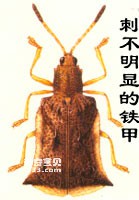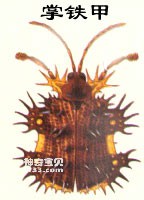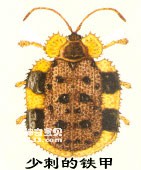The body of the armor is generally elongated, and there are often spikes or knobs on the back and elytra of the body, making it look like a warrior wearing iron armor, so it is called the armor. The iron armor mentioned here is in a narrow sense, referring to the iron armor subfamily of the iron armor family. There are 137 species in my country.
Ironclad insects are herbivorous insects. They are parasitic on monocots of angiosperms and feed on stems, buds or leaves. They are divided into two types: latent and epiphytic in their young stages. According to current knowledge, adults generally overwinter, and the number of generations that occur each year varies by species and region.
1. Generation generation
The number of generations can be divided into two types according to whether they are stable or not: (1) Definitive type, that is, within the distribution range of the species, regardless of regional differences, its generation generations are constant or basically stable; many The monotonic type of diapause belongs to this type. (2) Heterogeneous type, that is, the generation of occurrence varies with different regions, such as longitude, latitude, altitude, etc.; several genetic types. Including undergraduate students, generally belong to this type. For example, rice armor produces six generations a year in Guangdong and three generations a year in Hunan.
2. Feeding method
The feeding habits of herbivorous insects can be observed from three aspects, namely the object, part or method of feeding. The object refers to which plant or type of plant, the part refers to which parts of the plant, and the method refers to how to feed. The adult beetles feed on leaves in the same way; the larvae feed on leaves.
3. Mating behavior
The mating behavior of insects can be divided into two types according to the number of matings: (1) one-time mating type, (2) multiple mating type. The former only mates once in their lifetime, especially females; the latter can mate multiple times for both sexes. Among insects of the one-mating type, males can generally mate multiple times, but after mating, the female will develop resistance behavior or produce refractory secretions to prevent the male from coming a second time; A few insects only mate once due to the extremely short adult period. The multiple mating type can be divided into two subtypes: (1) true multiple mating type, (2) pseudo multiple mating type. The number of matings in the former is related to yield or fecundity. A higher number of matings means higher egg production and stronger fecundity. The number of matings in the latter has no significant effect on egg production or fecundity. One normal mating and multiple matings It is basically the same for spawning and reproduction. Identifying insect mating types is an important key to the design and implementation of certain controls, such as sterility control. According to the above classification, insects of this class belong to the pseudo-multiple mating type. According to records, rice ironclads mate many times in their lives. Female rice beetles often reject males if they meet them just after mating, but after laying several eggs, they crawl around again looking for males to mate with again. According to the observation of the researchers, there is no significant difference in the number of days and eggs laid between the two when the females who mate once are reared alone and those who are raised with both sexes so that they mate frequently.
According to reports, rice ironclads in my country have obvious clustering phenomena after emergence and before mating, and they gradually spread during the spawning period. Some people think that this is feeding in groups, not mating in groups. Of course, feeding in groups is also conducive to finding mates and mating.
Most species of armored males and females have back-end vocalizers, which should play a certain role in attracting each other and finding mates for mating. Unfortunately, there has been no observational experiment in this regard in the past. Many insects often engage in "marriage play" behavior before mating. It has been observed that before mating, the male and female of the rice iron beetle confront each other. They first shake their antennae from side to side, then rub against each other, and then mate.
4. Egg-laying habits
Ironclad eggs have no ootheca and are laid within the leaf epidermis. For example, rice iron beetles lay eggs in the epidermis of rice leaves. Before laying eggs, the female uses her mouthparts to scrape the epidermal layer of the leaf, and then lays eggs, one at a time. After laying eggs, the colloid is discharged from the ovipositor to seal the cracks in the epidermal membrane.
The hind wings of insects of this class are generally well developed, and no degeneration has been found. But they don't fly often. When frightened, they often fall from the leaves and pretend to be dead. They rarely fly and escape before falling to the ground. They generally do not gather under lights at night, and they are rarely caught. According to observations, they all overwinter in adult form and live in dead leaves and stubs of host plants, or in weeds, soil gaps, and stone gaps. Rice ironclads mainly hide in weeds beside fields, but they are also often found among rice roots and under clods of soil.

5. Unknown thorn weakness - trench chest wedge armor
Body length 6-6.5 mm; body width 4.2-4.4 mm. Body wedge-shaped. Brown-yellow; the four segments at the ends of the antennae are brown and black, and there are three black-purple longitudinal bands in the middle and both sides of the pronotum, with the middle longitudinal band being narrower; the coleoptera and the posterior horns are black-purple with a copper-colored luster.
The top of the head has a roughly carved point; the antennae are slender, reaching almost half the body length. The ends are enlarged. Section 1 is spherical and the shortest. Sections 2-7 are slightly larger at the base. Section 3 is the longest, which is the sum of the lengths of sections 1 and 2. Section 4 is only smaller than section 3, and the remaining sections are similar in length. Segments 8-10 are short, covered with gray hairs, and the ends of the distal segments are narrow and pointed. The pronotum is square, the front end is slightly narrow, the front teeth end of the front side angle is forward, the back teeth end is outward, the surface is densely carved, there is a thin longitudinal ridge in the center, and there is a very fine groove on it. Scutum triangular, broad at base and narrow at end. The base of the elytra is slightly enlarged, the rear part is slightly expanded, and the lateral edges have small teeth; the posterior lateral angle extends outwards, and the entire angle is concave and dorsally arched; the posterior edge is arched, the odontoid process is not obvious, and the suture corners are slightly concave; the plate area is inscribed The dots are deep and dense, and the dots in the outermost dot row are larger and have transverse ridges, forming small grids on the open edge; the small scutellum row has 4-5 dots. The plate area has a tumorous process and the top is blunt and rounded.
Distribution: Yunnan; India.

6. Thorns as strong as nails - Narrow-leaf Palm Armor
Body length 4.5-5.6 mm; body width 2.5-3 mm. The background color is brownish-yellow, and most of the back is black or brown; the head is dark red to brown; the compound eyes, most of the pronotum, the ends of the prothoracic lateral leaf spines, the small scutellum, the dorsal spines of the elytra and part of the wing surfaces are all red. Black, the front and rear leaves and spines and 1-2 terminal edge spines close to the rear leaves are reddish brown to black, the open edge and terminal edges between the two leaves are yellow to yellowish brown, and the ventral surface of the chest is dark brown to dark brown.
The head is short and slightly wider than the front edge of the chest; the base of the forehead and lips are wide and raised, with a rough surface and fine hairs, and sometimes the base is slightly dark brown or black; the top of the head is almost square between the eyes, and the hair is short and thin, not very obvious. The midline is concave and extremely obvious, and there is a black spot in the middle of the posterior edge, which may or may not be extremely obvious. The length of the antennae is about two-thirds of the body length or slightly shorter. The two base segments are slightly darker in color, and the end segments are slightly thicker and covered with dense yellow hairs. The first segment is nearly cylindrical, twice as long as the width, and the second segment is nearly cylindrical. The segments are short, about half the length of the previous segment. The third segment is thin and longer than the first two segments. The length of segments 4-6 and 9 gradually decreases. The length of segment 4 is about half of the length of segment 3. The length of segment 6 and 7 is two. The segments are almost equal in length, the last segment is equal to the sum of the 7th and 8th segments or slightly longer, and the ends are narrow and narrow. The prothorax is flat, wider than long, with a narrow front edge and a broad base; the back plate is rough in wrinkles and covered with long and slender hairs; the lateral leaves of the prothorax are narrow and long, slightly obliquely upward, with 6 spines at the end of the leaf, the first spine Very short and small, located at the base of the leaf, pointing inward or slightly backward; the four middle spines are all slender and approximately equal in size; the fifth spine is relatively horizontal and flat, and its rear edge is much longer than the front edge; the sixth spine is short. The scutellum has a wide base, narrow rounded ends, and a concave middle. The elytra are long, shiny, with prominent shoulders, densely covered with erect hairs, and have 10 rows of engraved dots. The edge of the elytra is open, and it expands into a leaf shape front and back. The front leaf is large with 5 spines, and the rear leaf is narrow with 3 spines.
Distribution: Yunnan, Hainan; Vietnam.

7. Shaped like a tortoise shell - Tibetan turtle armor
The body is 6 mm long and 5 mm wide, nearly round and resembles a tortoise shell. The pronotum panel is black, the front and rear edges of the panel and the open edge are blood red; the scutes are black; the elytra are blood red with two large black spots on the open edge; the spines are black; the ventral surface is black; the legs are yellow ,The base section, trochanter and leg section are black.
The prothorax and elytra are bulging on both sides, and the open side is wide. The head appears narrower than the prothorax, and the frontal and labial base is extremely prominent, triangular, with a rough surface, and a ridge between the two antennae. The compound eyes are large, with a bulge between the eyes on the top of the head and wrinkles. The antennae have 9 segments, up to half the body length, thin in the middle and slightly thicker at both ends. The 3rd segment is the longest, followed by the last segment. The apex segments are covered with light yellow short hairs. The front chest is extremely wide, with fine transverse wrinkles on the surface of the panel, a transverse concave at the base, bulging open edges on both sides, and 12-13 serrations on the edges. The open surface has irregular window spots. The scutellum is wide at the base, narrow and rounded at the end, all wrinkled, and has thickly carved spots in the depression at the base. The elytra are long and oval, with raised panels, irregular rows of engraved points, small scutes and dotted rows, the distance between rows and ridges is very inconspicuous, the spines on the wings are sparse, and the two large spines are in front of the middle of the first ridge and in the middle of the first ridge. Behind the middle of the 2nd ridgeline; there are 4 medium-sized spines, one at the end of the 1st ridgeline, one at the base of the 2nd ridgeline, and the other two at the middle and end of the 4th ridgeline. There is one (or two) on the shoulder blade. ) cone spines. In addition, there are some sparse thorns. The open edge is wide, about half the width of each wing, the middle part of the side edge is slightly concave, the edge has 31-36 serrations, there are window spots on the surface, and the base and middle part are concave. The legs are short and covered with light yellow short hair. The appendage is wide, but much shorter than the tibia, and the first appendage is short.
Distribution: Tibet.

8. Typical representative—double-thorned iron armor
Body length 4.4-6.2 mm, width 1.8-2.6 mm. The back is mostly black. The elytra have light yellowish brown markings. The thoracic spines, elytra dorsal spines and lateral spines are black, and the bases of the terminal spines are yellow; the ventral surface of the thorax is black, and the center of the metathorax and abdomen is brown or reddish-brown; the legs and abdomen are yellow to yellowish brown. The antennae are brownish-yellow, and the base 2 nodes are darker, sometimes dark brown.
The top of the head is smooth with a longitudinal groove in the center. The antennae are slender, reaching 3/4 of the body length, with smooth base segments, and slightly thicker terminal segments with dense white pubescence; the 1st segment is thicker, and the 2nd segment is 1/2 of the 1st segment. , Section 3 is the longest, Section 4 and Section 5 are equal in length, Section 6 is slightly shorter than Section 5 and Section 7, Section 8-10 is equal in length but shorter than Section 6, and the last section is long and pointed. The length and width of the forechest are approximately equal; the panel is densely covered with dots and white pubescence, with an undotted matte transverse process area in the center, and a vertical stripe runs through the center of the area; there are 2-3 terminal ends on the pectoral spines. Small spines with fine hairs; 2 front spines on each side, long and thick back spines, short and thin front spines, about 1/2 the length of the back spines; 2 side spines on each side, long front spines, end The base is slightly curved, the back spine is short, about 1/3-1/4 of the length of the front spine, or shorter, and the bases of the two are closely connected. The small scutellum is triangular, with an obtuse rounded end; the wing points are large and irregular, with one tiny procumbent hair on each point, and longer erect hairs on the rows; there are 10 rows of points on the base and end, and there are 10 rows of points on the middle part. There are 8 rows, and the middle parts of rows 3, 4, 9, and 10 are merged into one row respectively; the dorsal spines are long and sharp: there is a row of small spines on the median suture. There are 4 small spines on the side of the scute. The lateral spines are about the same length as the dorsal spines, exceeding 2/3 of the wing width, and several spines on the posterior corners are shorter; the terminal spines are smaller, about 1/3 or 1/4 of the length of the lateral spines; There are about 12 to 14 spines on the margin and terminal margin; there are often micro-spines or spinous processes with fine hairs at the ends between the large spines on the lateral margin. There are small spines on the inside of each leg segment.
Distribution: Yunnan; Sikkim, Myanmar, India.
animal tags:
We created this article in conjunction with AI technology, then made sure it was fact-checked and edited by a Animals Top editor.